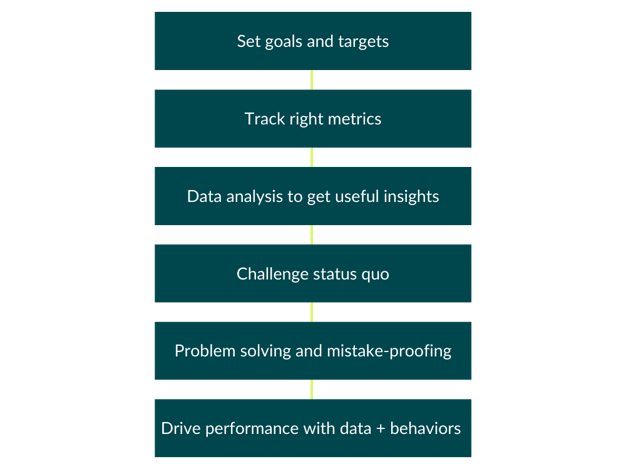

5 Smart Manufacturing Trends to Boost Productivity.
Navigating the technology landscape to build a smart factory may seem daunting. In this blog, we will explore 5 smart manufacturing trends that boost productivity.
Smart manufacturing =
Intelligent manufacturing IT systems and sensors combined with flexible workforce training and rapid design changes to boost productivity and adaptability.
→Let's dive deeper into the top 5 manufacturing trends you should be talking about at the moment.

1. Training and skills.
Skilled workers are in high demand as the workforce changes. Phenomenons like "the great resignation" and technology reducing the need for manual labor fuel this change.
Employers recognize the value of skills-based frontline training and recruitment, seeking candidates with the necessary experience and upskilling existing workforces.
Soft skills, such as communication and problem-solving, are also becoming more important.

💡 Article tip:
The Meaning of Training within Industry (TWI) in the 2020s.
2. Process automation and optimization.
Digital technologies that aim to automate and optimize processes are also in high demand in smart factories. Think about solutions around AI, automation, digital twins, and IIoT technology.
Manufacturing data analysis and collection, decision-making, and production are optimized with these technologies to enhance operations and improve outcomes.
By connecting machines and equipment and using analytics and sensors, industries can achieve optimum efficiency, reduce waste and emissions, and monitor quality control. Digital twinning provides a cost-effective way to experiment and analyze systems in the virtual world.

💡 Article tip:
Best Practices: Data Analytics & Visualization in Manufacturing.
3. Supply chain disruption.
Global supply chain disruptions persist due to various ongoing and emerging issues such as the pandemic, geopolitical tensions, inflation, cybercrime, and climate change.
However, this situation presents an opportunity for innovative leaders to leverage smart manufacturing solutions such as automation and IoT to drive efficiency and reduce waste.
Successful companies will be those that remain agile and use technology to gain end-to-end visibility and control over their supply chains.

💡 Article tip:
Disrupted Supply Chain? Don’t Reinvent the Wheel—Optimize it.
4. Long-term sustainability.
Manufacturing is joining the global efforts to reduce CO2 emissions and become more sustainable.
End-to-end supply chain traceability is becoming important as manufacturers aim to prove the ethical and sustainable sourcing of materials and clean energy usage.
Today, sustainability is not only a matter of moral principles but also a business priority, as consumers are increasingly basing their buying decisions on it.
.png?width=500&height=500&name=sustainable%20profitability%20circular%20manufacturing%20(1).png)
💡 Article tip:
Sustainable Profitability and Less Waste with Circular Manufacturing.
5. Decentralized manufacturing.
Decentralized manufacturing aims to produce products close to where they will be used, as opposed to centralizing production in hubs and transporting goods to consumers.
This smart manufacturing trend helps to reduce waste, warehousing costs, and transportation emissions, while also allowing for customization and personalization-at-scale. Also visit our Deployment Updates
- Examples: fablabs, maker spaces, and pop-up factories that use 3D printing and other additive manufacturing techniques.
These innovative approaches to manufacturing offer opportunities to reduce environmental impact and create more efficient and sustainable supply chains.
.png?width=800&height=418&name=future%20factory%20(1).png)
💡 Article tip:
The Future Factory is Built on Data. Future-Proof Your Operations.
Learn more about smart manufacturing trends:
👉 Want to Build the Factory of the Future? Focus on these 4 Areas.
👉 The Future is Bright for the Deskless Workforce
👉 The Human Side of Manufacturing Technology
Author
Revisions
It's time to simplify frontline training
Work instructions, checklists, and skills management - all in SwipeGuide
- Cut training time by 50%
- SOC I and II compliant
Get to know us
SCHEDULE YOUR DEMOResources
-
1
How to empower your frontline with better instructional design. -
2
How to gain the edge in Industry 4.0 with smart manufacturing practices. -
3
How to make excellent digital work instructions. -
4
How to deliver continuous improvement at the frontline with Lean principles. -
5
How to capture, share, and improve expert knowledge with digital SOPs.



